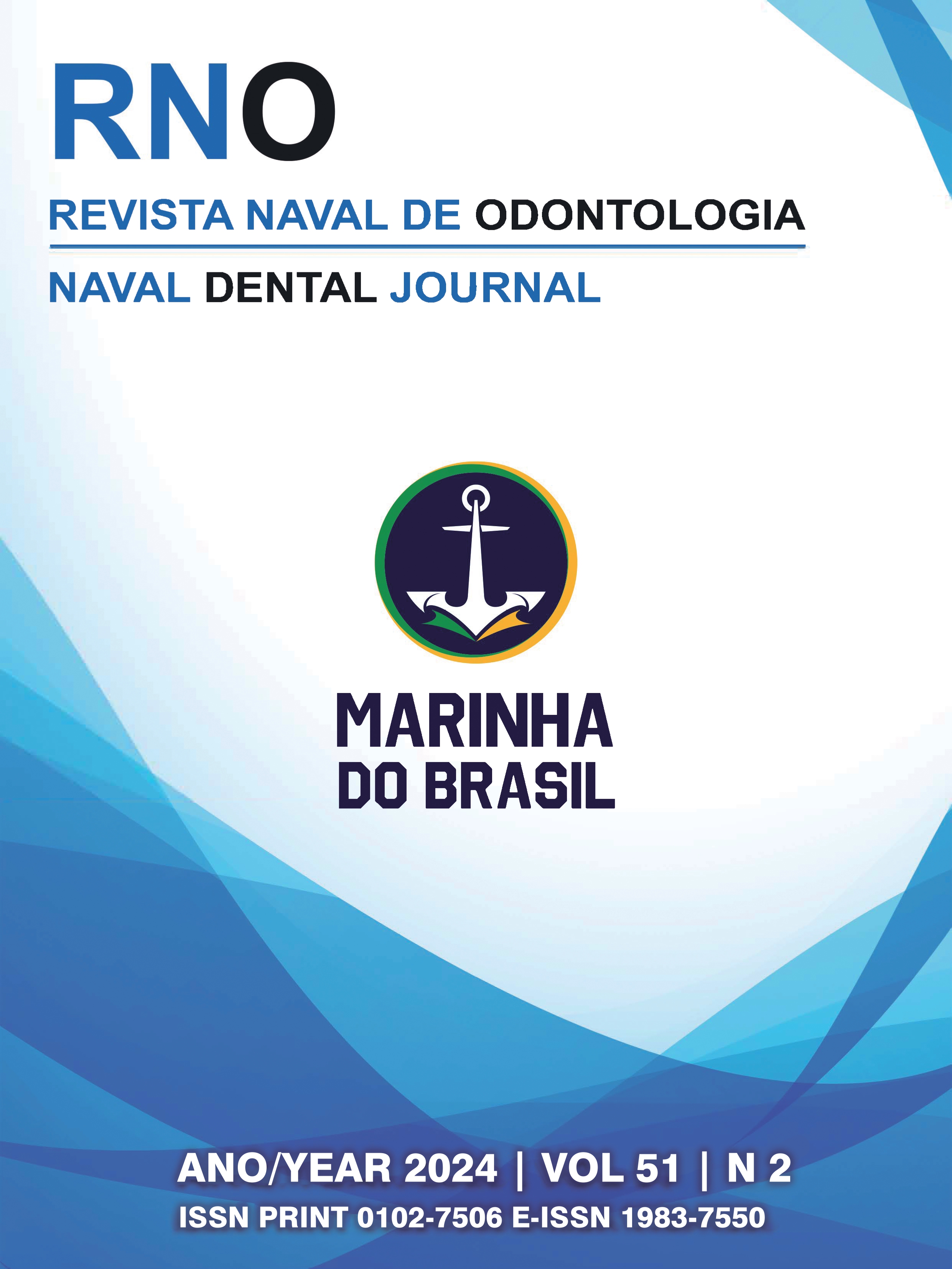IMPACTO DA PANDEMIA DE COVID-19 NO AUMENTO DAS URGÊNCIAS POR DISFUNÇÕES TEMPOROMANDIBULARES: UM ESTUDO TRANSVERSAL
##plugins.themes.bootstrap3.article.main##
Resumo
A COVID-19 é uma doença que apresenta um largo espectro clínico que varia de quadros totalmente assintomáticos a quadros graves de infecção pulmonar. O isolamento social recomendado pelas autoridades sanitárias, apesar de necessário para impedir a disseminação da doença, pode ter repercutido negativamente na saúde mental da população, gerando aumento do número de casos de ansiedade, depressão e outros transtornos psicológicos. Neste contexto, a disfunção temporomandibular (DTM), uma doença de caráter multifatorial, entre eles o fator psicológico, pode ter sido agravada após o início da pandemia. O objetivo deste estudo foi verificar se houve ou não o agravamento dos sintomas de DTM no período de pandemia, e quais foram eles. A pesquisa foi realizada em pacientes atendidos na Clínica de DTM da Odontoclínica Central da Marinha (OCM), situada da cidade do Rio de Janeiro-RJ, Brasil. Foi realizado um estudo transversal retrospectivo através da coleta de dados em 784 prontuários eletrônicos, de pacientes a partir de 12 anos, antes da pandemia, em 2019, e durante a pandemia, em 2020, de acordo com os critérios de elegibilidade. Os resultados obtidos, através de análises estatísticas, revelaram agravamento dos sintomas de DTM no período pandêmico. Houve aumento em consultas de emergência e em quadros de dores musculoarticulares. Concluiu-se que o agravamento dos sintomas de DTM pode estar associado à repercussão negativa da pandemia na saúde mental dos pacientes da OCM.
##plugins.themes.bootstrap3.article.details##

This work is licensed under a Creative Commons Attribution-NonCommercial-NoDerivatives 4.0 International License.
Referências
2. Sena MF, Mesquita KS, Santos FR, Silva FW, Serrano KV. Prevalence of temporomandibular dysfunction in children and adolescents. Rev Paul Pediatr. 2013;31(4):538–545.
3. Zakrzewska JM. Temporomandibular disorders, headaches and chronic pain. J Pain Palliat Care Pharmacother. 2015;29(1):61–63.
4. Magnusson T, Egermark I, Carlsson GE. A longitudinal epidemiologic study of signs and symptoms of temporomandibular disorders from 15 to 35 years of age. J Orofac Pain. 2000;14(4):310–319.
5. Conti PC, Pinto-Fiamengui LM, Cunha CO, Conti AC. Orofacial pain and temporomandibular disorders: the impact on oral health and quality of life. Braz Oral Res. 2012;26 (Suppl 1):120–123. 3.
6. Zakrzewska JM. Temporomandibular disorders, headaches and chronic pain. J Pain Palliat Care Pharmacother. 2015;29(1):61–63.
7. Suvinen TI, Reade PC, Kemppainen P, Könönen M, Dworkin SF. Review of aetiological concepts of temporomandibular pain disorders: towards a biopsychosocial model for integration of physical disorder factors with psychological and psychosocial illness impact factors. Eur J Pain. 2005;9(6):613–633
8. Graff-Radford SB. Temporomandibular disorders and headache. Dent Clin North Am. 2007;51(1):129–144
9. Umakanthan S, Sahu P, Ranade AV, Bukelo MM, Rao JS, Abrahao-Machado LF, Dahal S, Kumar H, Kv D. Origin, transmission, diagnosis and management of coronavirus disease 2019 (COVID-19). Postgrad Med J. 2020 Dec;96(1142):753-758.
10. Umakanthan S, Sahu P, Ranade AV, Bukelo MM, Rao JS, Abrahao-Machado LF, Dahal S, Kumar H, Kv D. Origin, transmission, diagnosis and management of coronavirus disease 2019 (COVID-19). Postgrad Med J. 2020 Dec;96(1142):753-758.
11. Ohrbach R, editor. Diagnostic Criteria for Temporomandibular Disorders:
Assessment Instruments. Version 15May2016. www.rdc-tmdinternational.org
Accessed on Sept 4th, 2024.
12. Sójka A, Stelcer B, Roy M, Mojs E, Pryliński M. Is there a relationship between psychological factors and TMD? Brain Behav. 2019 Sep;9(9):e01360. doi: 10.1002/brb3.1360. Epub 2019 Jul 24. PMID: 31339236; PMCID: PMC7649956.
13. Vindegaard N, Benros ME. COVID-19 pandemic and mental health consequences: Systematic review of the current evidence. Brain Behav Immun. 2020 Oct;89:531-542.
14. Emodi-Perlman A, Eli I, Smardz J, Uziel N, Wieckiewicz G, Gilon E, Grychowska N, Wieckiewicz M. Temporomandibular Disorders and Bruxism Outbreak as a Possible Factor of Orofacial Pain Worsening during the COVID-19 Pandemic-Concomitant Research in Two Countries. J Clin Med. 2020 Oct 12;9(10):3250.
15. Peixoto KO, Resende CMBM, Almeida EO, Almeida-Leite CM, Conti PCR, Barbosa GAS, Barbosa JS. Association of sleep quality and psychological aspects with reports of bruxism and TMD in Brazilian dentists during the COVID-19 pandemic. J Appl Oral Sci. 2021 Jul 23;29:e20201089.
16. de Melo Júnior PC, Aroucha JMCNL, Arnaud M, Lima MGS, Gomes SGF, Ximenes R, Rosenblatt A, Caldas AF Jr. Prevalence of TMD and level of chronic pain in a group of Brazilian adolescents. PLoS One. 2019 Feb 8;14(2):e0205874.
17. Yadav S, Yang Y, Dutra EH, Robinson JL, Wadhwa S. Temporomandibular Joint Disorders in Older Adults. J Am Geriatr Soc. 2018 Jul;66(6):1213-1217. doi: 10.1111/jgs.15354. Epub 2018 May 2. PMID: 29719041; PMCID: PMC6699643.
18. Moharrami M, Bohlouli B, Amin M. Frequency and pattern of outpatient dental visits during the COVID-19 pandemic at hospital and community clinics. J Am Dent Assoc. 2022 Apr;153(4):354-364.e1.
19. Colonna A, Guarda-Nardini L, Ferrari M, Manfredini D. COVID-19 pandemic and the psyche, bruxism, temporomandibular disorders triangle. Cranio. 2021 Oct 15:1-6.
20. Minervini G, Franco R, Marrapodi MM, Mehta V, Fiorillo L, Badnjević A, Cervino G, Cicciù M. The Association between COVID-19 Related Anxiety, Stress, Depression, Temporomandibular Disorders, and Headaches from Childhood to Adulthood: A Systematic Review. Brain Sci. 2023 Mar 12;13(3):481.
21. Yap AU, Sultana R, Natu VP. Stress and emotional distress: their associations with somatic and temporomandibular disorder-related symptoms. Psychol Health Med. 2022 Apr;27(4):876-887. doi: 10.1080/13548506.2021.1908571. Epub 2021 Apr 20. PMID: 33879010.
22. Saczuk K, Lapinska B, Wawrzynkiewicz A, Witkowska A, Arbildo-Vega HI, Domarecka M, Lukomska-Szymanska M. Temporomandibular Disorders, Bruxism, Perceived Stress, and Coping Strategies among Medical University Students in Times of Social Isolation during Outbreak of COVID-19 Pandemic. Healthcare (Basel). 2022 Apr 15;10(4):740.

